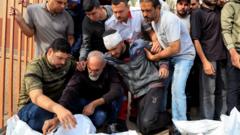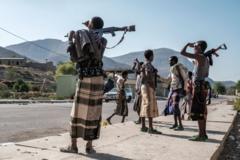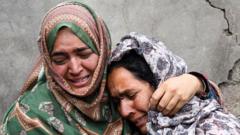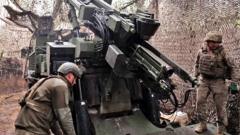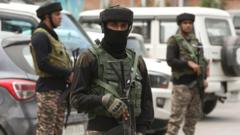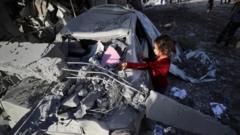*In the latest round of violence, India and Pakistan engaged in intense military exchanges, impacting innocent lives and prompting urgent calls for a ceasefire amid fears of escalation.*
**Escalating Tensions: A New Flashpoint in the India-Pakistan Conflict**
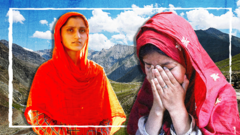
**Escalating Tensions: A New Flashpoint in the India-Pakistan Conflict**
*The recent clashes highlight the fragility of peace in a long-standing conflict, leading to civilian casualties and international intervention.*
In a shocking outbreak of violence, the conflict between India and Pakistan escalated dramatically in recent days, sending shockwaves through the region. Conflicts over the disputed Kashmir territory culminated in a series of devastating military exchanges, including missile strikes and intense shelling that have resulted in tragic civilian casualties on both sides.
Among the tragic stories is that of 16-year-old Shazia, who stood frozen in horror as Indian missiles struck her village in Pakistan-administered Kashmir. She was injured in the chaos, unaware of the piece of shrapnel lodged in her chest as she and her family fled to a relative's house. Meanwhile, across the border in Indian-administered Kashmir, the Sudhan family experienced their own nightmare when a shell exploded near them, resulting in the death of 13-year-old Sameer. His grandfather, Mr. Sudhan, lamented the loss, stating, "Our future was shattered in an instant."
The flare-up was triggered after a militant assault in India-administered Kashmir claimed 26 lives, of which the Indian authorities attributed part of the blame to Pakistan. This allegation has led Pakistan to demand proof and call for an independent investigation into the attack. The following days involved a relentless cycle of retaliatory strikes, marking some of the most severe violence seen in recent years, as both countries traded blows, putting their military capabilities on full display.
With civilian safety compromised, reports indicate a rising death toll, with India reporting at least 16 casualties and Pakistan asserting around 40 deaths, although the accuracy of these figures remains contested. Eyewitness accounts from both regions depict the horror of ordinary lives uprooted in the crossfire, as families hurriedly evacuated their homes only to find themselves caught in more violence.
Despite the growing chaos, regional tensions took a diplomatic turn when a ceasefire was brokered, assisted by international intervention from countries like the United States. President Biden commented that "peace is achievable through dialogue," indicating a will to stabilize the region.
Local residents now find themselves grappling with a grim reality—loss, destruction, and the haunting specter of insecurity. Amid these crises, voices like Shazia's mother resonate, calling on both governments to prioritize civilian safety in their military strategies. Many merely wish for a return to the relative peace they had experienced prior to this latest turmoil, with hopes that negotiations can steer their lives away from the brink of war.
As the dust settles, the wounds and scars of this conflict remain deep, emphasizing once again the delicate balance of peace in one of the world's most volatile region, where every moment holds the potential for unforeseen tragedy.
Among the tragic stories is that of 16-year-old Shazia, who stood frozen in horror as Indian missiles struck her village in Pakistan-administered Kashmir. She was injured in the chaos, unaware of the piece of shrapnel lodged in her chest as she and her family fled to a relative's house. Meanwhile, across the border in Indian-administered Kashmir, the Sudhan family experienced their own nightmare when a shell exploded near them, resulting in the death of 13-year-old Sameer. His grandfather, Mr. Sudhan, lamented the loss, stating, "Our future was shattered in an instant."
The flare-up was triggered after a militant assault in India-administered Kashmir claimed 26 lives, of which the Indian authorities attributed part of the blame to Pakistan. This allegation has led Pakistan to demand proof and call for an independent investigation into the attack. The following days involved a relentless cycle of retaliatory strikes, marking some of the most severe violence seen in recent years, as both countries traded blows, putting their military capabilities on full display.
With civilian safety compromised, reports indicate a rising death toll, with India reporting at least 16 casualties and Pakistan asserting around 40 deaths, although the accuracy of these figures remains contested. Eyewitness accounts from both regions depict the horror of ordinary lives uprooted in the crossfire, as families hurriedly evacuated their homes only to find themselves caught in more violence.
Despite the growing chaos, regional tensions took a diplomatic turn when a ceasefire was brokered, assisted by international intervention from countries like the United States. President Biden commented that "peace is achievable through dialogue," indicating a will to stabilize the region.
Local residents now find themselves grappling with a grim reality—loss, destruction, and the haunting specter of insecurity. Amid these crises, voices like Shazia's mother resonate, calling on both governments to prioritize civilian safety in their military strategies. Many merely wish for a return to the relative peace they had experienced prior to this latest turmoil, with hopes that negotiations can steer their lives away from the brink of war.
As the dust settles, the wounds and scars of this conflict remain deep, emphasizing once again the delicate balance of peace in one of the world's most volatile region, where every moment holds the potential for unforeseen tragedy.








